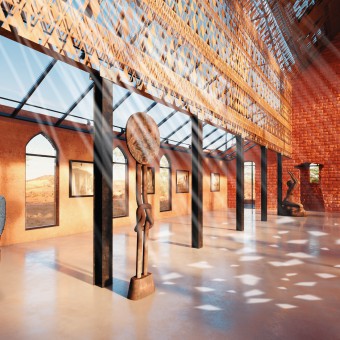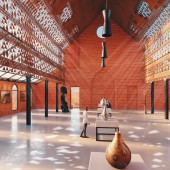DESIGN NAME:
Old Palapye Museum
PRIMARY FUNCTION:
Historic Building Preservation, Museum
INSPIRATION:
The outstanding burnt brick church ruins stand proudly within perimeters of a rich historic site of the 19th century capital of the Bangwato tribe that was led by the royal king Khama III- one of the most powerful Tswana kings. The old church ruins and other remaining artifacts from the settlement tell the story of the old capital. Built in 1891 by the London Missionary Society, it was later abandoned after the royal King Khama III relocated his capital to another prosperous site after the current one had suffered from lack of resources to sustain the capital.The church was then left to the devices of nature, a slow process of deterioration led to its dilapidated state. However the whole site area was then gazette as a national monument in 1938 in order to be protected and preserved. Today it remains as a famous tourist site in the region and now considers proposals for a new museum development. So the architect designed a museum and exhibition space that reflect on the old capitals image. By working with the existing ruins, it was essential not to override them but rather create a new life around them. The designs intentions was to preserve the historical heritage of the ruins by adding a contemporary feel and simultaneously breathing new life into it, therefore highlighting the contrast between old and new.
UNIQUE PROPERTIES / PROJECT DESCRIPTION:
The design considered keeping the ruins in their original state, therefore a structural steel framework was introduced to rebuilt the old structure of the church by referring to its old photos. The height, form, windows of the old church were reconstructed with modern materials –corten steel to represent the hue of the burnt brick ruins and for the wall enclosure, steel for the structural frame and metal roofing. The metal roofing is patterned with the traditional pattern of the old royal house/homestead. It is often reflective of the Tswana traditional pattern used to adorn the traditional walls and houses. The pattern cutouts reflect light into the interior (previous church nave of the old church) of the museum and give a great ambience to the exhibition display. The two opposite spaces of the nave/exhibition space form the old church aisles, which now form the historic information display of the museum. The two spaces are flooded by light from the top glass and steel roof. The overall shape of the museum is the form of the old church in a contemporary state, with new added values and function. Therefore the imagery and history of the church and its historic site are brought back into life.
OPERATION / FLOW / INTERACTION:
Upon designing the museum, the objective was to create a museum that tells the history of the chiefdom and missionaries that occupied and used the old church which was abandoned, as well as to use the new museum as an exhibition space for new and old artworks for the region. The museum has three major spaces and two secondary spaces. The major spaces are the exhibition space which is in the centre, the two other spaces are the historic information display spaces on the left and right sides of the main exhibition spaces. The auxiliary spaces are the grand entry and the steeple which are enclosed by steel and glass. The steeple forms the main anchor and landmark for the museum which acts as a reflective lighthouse by night.
PROJECT DURATION AND LOCATION:
Project is a proposal that started in end of 2018, it is located in Palapye, Botswana
FITS BEST INTO CATEGORY:
Architecture, Building and Structure Design
|
PRODUCTION / REALIZATION TECHNOLOGY:
The whole structural frame is formed by pre-fabricated steel frames that are evenly spanned along the entire width of the foundation ruin. The intention is that after they are completed on site, they take the form of the original church. The building envelope is a corten steel that wrap around the steel structural framing, right from the interior to the exterior of the building envelope. It is also used as double enclosure walls on the sides. The corten steel compliments the burnt brick ruins as it rusts. Glass and steel is used as the sloping roof on the two identical display spaces on opposite sides of the main exhibition of the museum. It is also used as the structural frame for the steeple exhibition and the main façade entry. The glass floods in light and creates a continuation of the interior to the exterior landscape. The glass and steel are the contemporary materials that merge the old and the new.
SPECIFICATIONS / TECHNICAL PROPERTIES:
The museum is 380sqm in size
TAGS:
Preservation, historic, burnt brick, old Palapye museum
RESEARCH ABSTRACT:
In the era of rapid urbanization, many historical sites are left to further decay as most focus is put on future developments. Whenever the opportunity presents itself that these historical sites are given a much appreciated attention, it is important to understand the architectural challenge of finding the right approach for adopting a ruin in a historical site. This involves the form f the structure and the materials that have remained and exposed to weather elements over the years. By achieving a clear design approach for a successful merge of the old and the new through clever technical detailing and material aesthetics, a hybrid form can be presented that compliments both eras in time.
CHALLENGE:
A conservation assessment to help guide the restoration work has been done in collaboration with the community and Botswana National Museum. However if ever the project proposal is to be considered, further assessment of the structure in view of a new structure to be re constructed on the ruins will have to be conducted diligently with other specialist works.
ADDED DATE:
2019-02-28 03:24:33
TEAM MEMBERS (1) :
Beullah Serema
IMAGE CREDITS:
Noua pty Ltd., 2019
Shawn.M
PATENTS/COPYRIGHTS:
Copyrights belong to Beullah Serema,2019
|










